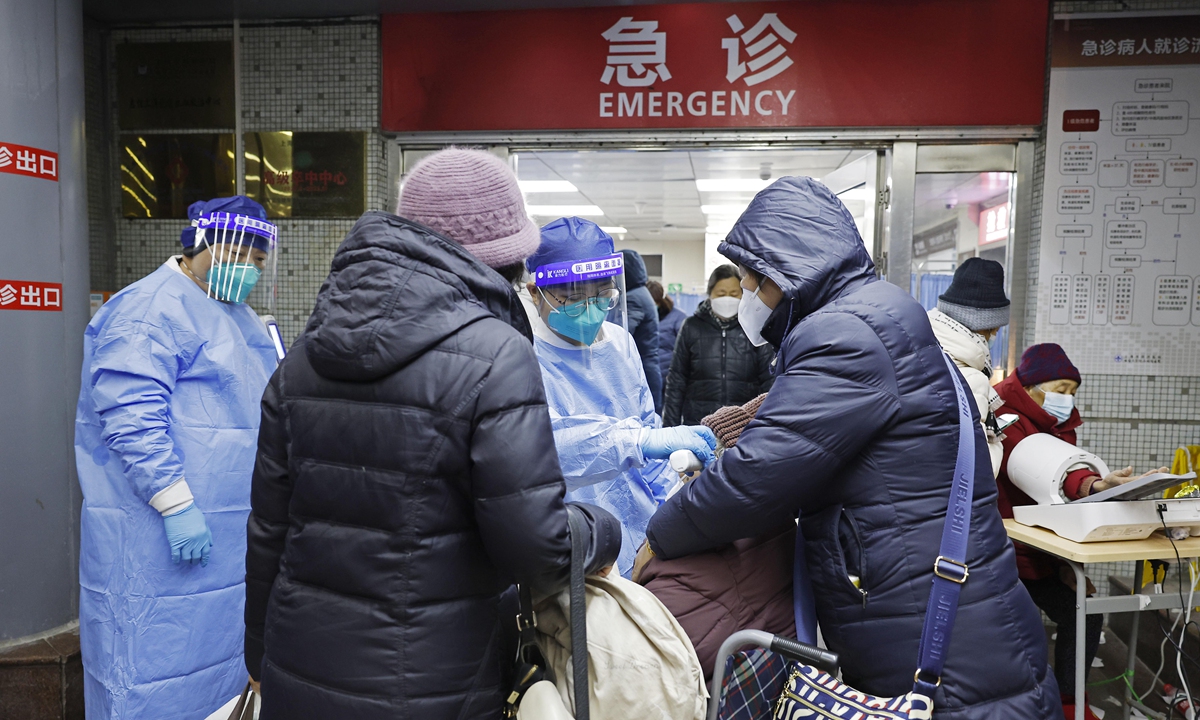
Doctors at Tongji Hospital affiliated to Tongji University check on an emergency patient in Shanghai on December 26, 2022. Photo: IC
Shanghai top-tier hospitals call for hospital visits by non-urgent patients shunted to sub-tier hospitals which have been prepared with diagnosis and treatment as well as both imported and domestic antiviral medicine for COVID-19, to leave life-saving emergency resources to critical cases, which have gradually peaked in the city.
Multiple prestigious third-tier hospitals in Shanghai including Ruijin Hospital and Renji Hospital, affiliated to the School of Medicine of Shanghai Jiao Tong University have seen their emergency patients double over the past few days as COVID-19 infections increase, and the city is set to encounter the peak of critical cases, The Paper reported on Friday.
At Ruijin Hospital, the number of visits paid to the emergency department has reached 1,500 per day, double the amount of the previous period, despite that the visits paid to the hospital's fever clinic are down from 600 visits per day to 300 visits per day, Chen Erzhen, deputy head of Ruijin Hospital told The Paper.
According to Chen, COVID-19 patients account for 80 percent of the emergency patients and elderly patients account for 40 percent to 50 percent of the COVID-19 patients. Since most of the elderly patients have underlying conditions, their diseases worsened after they were infected with COVID-19 and half of the elderly patients aged 65 or above have some symptoms of pneumonia.
At Renji Hospital, the number of emergency patients' visits reached 1,500 and 1,000 per day at the two branches of the hospital, according to Zhuang Xu, deputy director of the office of the hospital's outpatient and emergency departments.
Multiple third-tier hospitals advocated non-emergency patients visiting outpatient departments or the district-level second-tier hospitals or sub-district medical service centers to leave the life-saving resources at the top-tier hospitals to really critical patients.
"For third-tier medical institutions, concentrating on treating severe patients is the top priority at present," Chen said, noting that close attention is paid to those who are prone to severe conditions and critical patients with hypoxemia, chest tightness and shortness of breath.
According to Chen, the capacity for diagnosis and treatment at the community medical institutions and their medicine reserves are gradually improving. The district-level hospitals and community medical service institutions can meet the medical treatment demands of non-high-risk populations and those who simply have symptoms of common infections.
Besides, for those who have relatively severe symptoms, doctors at community medical institutions will make a choice according to the patients' conditions on whether they need to be transferred to medical institutions of higher level to assure graded and reasonable medical treatment, Chen noted.
According to Chen, the supply of antiviral medicines for COVID-19 will also be available at community health service centers, including both the domestically produced and the imported small-molecule antiviral drugs.
At present, multiple districts in Shanghai such as Jiading, Minhang and Songjiang, have improved and perfected their management measures for graded diagnosis and treatment.
In Jiading district, the community health service centers announced the contact information of 385 family doctors in the district to the public. Once the doctors find symptoms worsened, the patient will be transferred to the district-level hospital immediately, according to a statement from the district that introduces the graded treatment management.
Besides, the 13 community health centers in the district have all set up their fever clinics and part of the nucleic acid testing kiosks in the district have been transformed into fever clinics to give patients preliminary diagnosis and to speed up the process of medicine dispensing to ordinary patients.
In Minhang district, 38,266 visits have been paid to the fever clinics around the district over the past week, among which 26,313 visits were paid to the fever clinics at the community health service centers, accounting for 68.76 percent of the total number in the district, according to a statement shared with the Global Times.
As the two regional medical institutions, Shanghai Fifth People's Hospital, Fudan University and the Central Hospital of Minhang District, received respectively 1,264 and 1,446 emergency patients per day over the past week, undertaking the treatment of a large number of emergency and severe patients in the district.
Zhao Yuliang, an official from the district's health commission told the Global Times on Friday that both the imported Pfizer's Paxlovid and China-developed oral drug for COVID-19 treatment Azvudine have been available at the district's two regional medical institutions for patients aged 65 or above who risk turn into severe cases. Besides, Paxlovid is also available at community health service centers under prescription after a doctor consultation.
In Songjiang district, the four regional medical centers and 16 community health service centers have established a corresponding referral relationship to smooth a two-way referral system.
Additionally the 108 fever clinics in Songjiang have shared the pressure from the higher-level medical institutions allowing them to better focus on emergency and severe patients.




